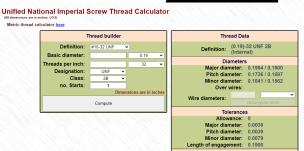mjk
Titanium
- Joined
- Oct 20, 2005
- Location
- Wilmington DE USA
May sound like a newbie question but I've not had to look for this before
When I purchase a tap, I'll look for eg 10-32 2,3,or flute, coated etc.....based on catalog recommendations, I'm not machining space station parts
I was at my local flea market Saturday and found a box containing cards of taps, all in the sizes that I normally use(break)
Price was right, 2 of the cards 12ea are HY-PRO with label 194-32 GS.
a version of 10-32?
When I purchase a tap, I'll look for eg 10-32 2,3,or flute, coated etc.....based on catalog recommendations, I'm not machining space station parts
I was at my local flea market Saturday and found a box containing cards of taps, all in the sizes that I normally use(break)
Price was right, 2 of the cards 12ea are HY-PRO with label 194-32 GS.
a version of 10-32?


